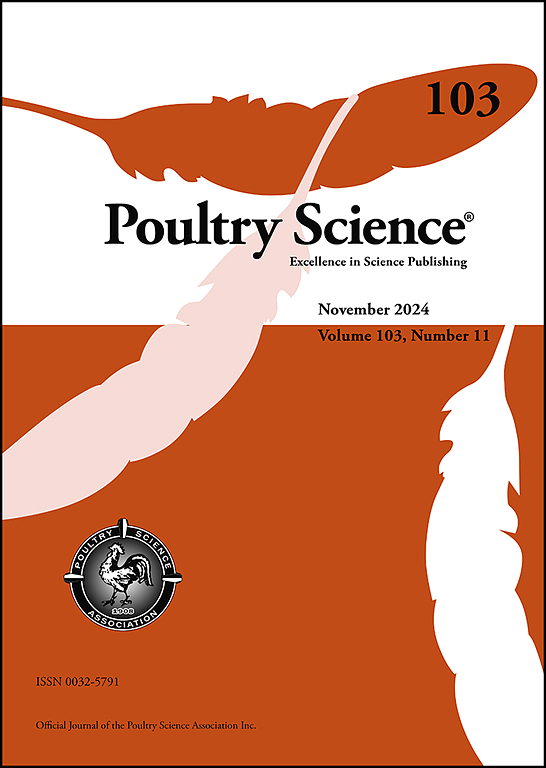Severe effects of Escherichia coli and Enterococcus faecalis on hatchability and first-week performance following inoculation of 18-day-incubated embryonated broiler eggs
IF 4.2
1区 农林科学
Q1 AGRICULTURE, DAIRY & ANIMAL SCIENCE
引用次数: 0
Abstract
In ovo vaccinations have been widely used in the poultry industry over the past three decades. During vaccination, various factors, including bacterial contamination of embryonated eggs, can negatively affect hatchability, chick quality and first-week performance. The aim of this study was to assess the effect of inoculation with different bacteria at incubation day 18 on hatchability, chick quality and first-week mortality. Furthermore, the effects of different bacterial doses on the same parameters were assessed.
First, inoculation strains were selected by isolating bacteria from unhatched, in ovo-vaccinated eggs in commercial hatcheries. A total of 23 bacteria species were isolated, with E. coli and E. faecalis being the most commonly found species in eggs from all hatcheries. The virulence of ten E. coli and ten E. faecalis isolates was assessed using an embryo lethality assay. Subsequently, the most virulent strains of E. coli and E. faecalis were selected for an animal experiment. Eighteen-day incubated embryonated broiler eggs were inoculated with 0.1 ml of bacteria suspension or peptone physiological saline, using 36 eggs per group. Three different bacterial doses (102, 104 or 106 colony-forming unit/egg) were used. Hatching rate, time of hatch, chick length, and Pasgar score were determined at the end of the incubation process and mortality, time of death, and chick weight in the first week of life.
Hatchability did not significantly differ between the different doses when E. faecalis was inoculated, ranging from 56 to 69 %. First-week mortality in these groups ranged from 36 to 86 %, while chick quality did not differ from the control groups. E. coli was pathogenic at all tested doses, with no chicks hatching in any of these groups. In all groups (E. coli and E. faecalis), severe drops in hatchability and increased first-week mortality were observed. Therefore, strict hygiene measures should be implemented in hatcheries during in ovo vaccination to prevent contamination of eggs with low numbers (<102 cfu/egg) of virulent bacteria, such as E. coli and E. faecalis.
大肠杆菌和粪肠球菌对18天孵育肉鸡胚蛋的孵化率和第一周生产性能的影响
在过去的三十年里,蛋鸡疫苗接种已被广泛应用于家禽业。在接种过程中,各种因素,包括胚蛋的细菌污染,都会对孵化率、小鸡质量和第一周性能产生负面影响。本研究的目的是评估在孵化第18天接种不同细菌对孵化率、雏鸡质量和第一周死亡率的影响。此外,还评估了不同细菌剂量对相同参数的影响。首先,通过从商业孵化场未孵化的、接种过卵的鸡蛋中分离细菌来选择接种菌株。共分离出23种细菌,大肠杆菌和粪肠杆菌是所有孵化场鸡蛋中最常见的细菌。10株大肠杆菌和10株粪肠杆菌分离株的毒力采用胚胎致死性测定法进行了评估。随后,选取致病性最强的大肠杆菌和粪肠杆菌进行动物实验。用0.1 ml菌悬液或蛋白胨生理盐水接种18 d的肉鸡胚蛋,每组36只蛋。使用三种不同的细菌剂量(102,104或106菌落形成单位/蛋)。在孵育过程结束时测定雏鸡的孵化率、孵化时间、雏鸡体长和Pasgar评分,以及出生后第一周的死亡率、死亡时间和雏鸡体重。不同接种剂量的粪肠球菌孵育率无显著差异,孵育率为56% ~ 69%。这些组的第一周死亡率在36% ~ 86%之间,而雏鸡质量与对照组没有差异。大肠杆菌在所有测试剂量下都是致病性的,在这些组中没有小鸡孵化。在所有组(大肠杆菌和粪肠杆菌)中,观察到孵化率严重下降,第一周死亡率增加。因此,在孵化场进行蛋疫苗接种时应采取严格的卫生措施,以防止大肠杆菌和粪肠杆菌等低毒力菌(102 cfu/个)的鸡蛋受到污染。
本文章由计算机程序翻译,如有差异,请以英文原文为准。
求助全文
约1分钟内获得全文
求助全文
来源期刊

Poultry Science
农林科学-奶制品与动物科学
CiteScore
7.60
自引率
15.90%
发文量
0
审稿时长
94 days
期刊介绍:
First self-published in 1921, Poultry Science is an internationally renowned monthly journal, known as the authoritative source for a broad range of poultry information and high-caliber research. The journal plays a pivotal role in the dissemination of preeminent poultry-related knowledge across all disciplines. As of January 2020, Poultry Science will become an Open Access journal with no subscription charges, meaning authors who publish here can make their research immediately, permanently, and freely accessible worldwide while retaining copyright to their work. Papers submitted for publication after October 1, 2019 will be published as Open Access papers.
An international journal, Poultry Science publishes original papers, research notes, symposium papers, and reviews of basic science as applied to poultry. This authoritative source of poultry information is consistently ranked by ISI Impact Factor as one of the top 10 agriculture, dairy and animal science journals to deliver high-caliber research. Currently it is the highest-ranked (by Impact Factor and Eigenfactor) journal dedicated to publishing poultry research. Subject areas include breeding, genetics, education, production, management, environment, health, behavior, welfare, immunology, molecular biology, metabolism, nutrition, physiology, reproduction, processing, and products.
 求助内容:
求助内容: 应助结果提醒方式:
应助结果提醒方式:


